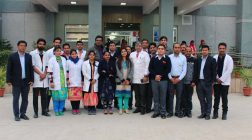80% of the diabetes deaths occur in middle-income countries, One in four in Chennai has diabetes!


Close to a quarter of Chennai’s population over the age of 20 has diabetes, and 38 per cent of people in the city over the age of 40 have the disease, a recent study reveals. The study also indicates that in the 45-plus age group, over 70 per cent has dysglycemia (either diabetes or pre-diabetes).
The yet-to-be published CARRS (Center for Cardiometabolic Risk Reduction in South Asia) study was conducted by the Madras Diabetic Research Foundation (MDRF), in collaboration with Emory University in the U.S., the Public Health Foundation of India, the All India Institute of Medical Research in New Delhi, and the Aga Khan Foundation in Karachi.
The CARRS study is being conducted in Chennai, New Delhi and Karachi. “The current results are from the first phase of the project that involved 4,000 people in each city. The second phase of the project is nearing completion,” said V. Mohan, chairman and chief diabetologist of Dr. Mohan’s Specialities Centre, who was part of the study, speaking to the press here on Monday.
“In 1972, the prevalence of diabetes was between 2 and 3 per cent in urban areas and 1.5 per cent in rural areas. In just over 40 years, it has increased ten-fold,” he said.
When the study’s data was compared to another study (the Mediators of Atherosclerosis in South Asians Living in America study), conducted in San Francisco among Indians living in the U.S., the prevalence of diabetes of people living in India was found to be higher, Dr. Mohan said. In the past, prevalence of diabetes amongst Indians living abroad was much higher than the prevalence in India; this trend is also changing.
“This means the conversion from pre-diabetes to diabetes in India is higher, indicating a need for lifestyle modifications,” Dr. Mohan said. He added genetic factors alone can’t explain this increased prevalence. “Lifestyle factors are a major contributor too,” he said.
R.M. Anjana, joint managing director, Dr. Mohan’s Diabetes Specialities Centre, said a sedentary lifestyle is a major contributing factor towards the increased prevalence. “Data from the ICMR’s INDIAB study indicates that a majority of people in the country lead sedentary lifestyles. In people who have very active lifestyles, the chance of getting diabetes is much lower than in those who lead sedentary lives,” she said.
In India diabetes is a huge problem and further spreading like wildfire. Even as nations prepare to mark World Diabetes Day on November 14, WHO says about 80% of the diabetes deaths occur in middle-income countries.About 1 million people died from diabetes in India in 2012 (1).
According to the International Diabetes Federation (IDF), India is currently home to over 61 million people with diabetes, an increase from 50.8 million in 2011. By 2030, India’s diabetes burden is expected to cross the 100 million mark as against 87 million estimated earlier (1).
The irony of the situation is that nearly 5 out of 10 Indians with diabetes aren’t even aware that they have diabetes (1), a disease that exposes them to heart attack, stroke, amputations, nerve damage, blindness and kidney disease. Almost every organ in the body can be adversely affected with the onslaught of diabetes but with timely intervention and care, the disease can be contained and complications can be prevented.
Diabetes affects people all over the country. Diabetes affects people both in urban and rural India though the impact on urban India is higher (2).Moreover, Indians get diabetes on an average 10 years earlier than their Western counterparts (3).
The factors contributing to our susceptibility to develop diabetes include:
1. Genetic – We have an increased predisposition to develop diabetes. A few genes have been identified which trigger diabetes making Indians four times more likely than Europeans to develop diabetes.
2. Diet – A typical Indian dietary profile includes high intake of carbohydrates, calories, total fat, saturated fat and sugar leading to obesity and thus increasing the diabetes prevalence rates.
As the number of people with diabetes grows, the disease consumes an ever-increasing proportion of health care budgets. Costs of diabetes care are alarmingly high. If one adult in a low-income family has diabetes, out of every Rs 100, Rs 25 will need to be devoted to diabetes care (4).
The costs of diabetes-care affects everyone, everywhere. It is not only a financial problem but intangible costs (pain, anxiety, inconvenience and generally lower quality of life) also have great impact on the lives of patients and their families and are the most difficult to quantify.
On a positive note, all of this can be prevented if we watch our blood sugar carefully, take appropriate action and intervene early and effectively.










